new posts in all blogs
Viewing: Blog Posts Tagged with: dante, Most Recent at Top [Help]
Results 1 - 7 of 7
How to use this Page
You are viewing the most recent posts tagged with the words: dante in the JacketFlap blog reader. What is a tag? Think of a tag as a keyword or category label. Tags can both help you find posts on JacketFlap.com as well as provide an easy way for you to "remember" and classify posts for later recall. Try adding a tag yourself by clicking "Add a tag" below a post's header. Scroll down through the list of Recent Posts in the left column and click on a post title that sounds interesting. You can view all posts from a specific blog by clicking the Blog name in the right column, or you can click a 'More Posts from this Blog' link in any individual post.

By: ChloeF,
on 2/27/2015
Blog:
OUPblog
(
Login to Add to MyJacketFlap)
JacketFlap tags:
*Featured,
medieval literature,
Dante: A Very Short Introduction,
David Robey,
Paradiso,
peter hainsworth,
The Divine Comedy,
Literature,
Religion,
shakespeare,
Philosophy,
VSI,
Europe,
very short Introductions,
theology,
Inferno,
Dante,
italian literature,
Add a tag
Dante can seem overwhelming. T.S. Eliot’s peremptory declaration that ‘Dante and Shakespeare divide the modern world between them: there is no third’ is more likely to be off-putting these days than inspiring. Shakespeare’s plays are constantly being staged and filmed, and in all sorts of ways, with big names in the big parts, and when we see them we can connect with the characters and the issues with not too much effort.
The post Why we should read Dante as well as Shakespeare appeared first on OUPblog.

By: DanP,
on 5/7/2014
Blog:
OUPblog
(
Login to Add to MyJacketFlap)
JacketFlap tags:
political polls,
dante,
flinders,
miliband,
spin doctor,
blasio,
axelrod’s,
advert,
British politics,
labour,
david cameron,
general election,
*Featured,
boris johnson,
american politics,
ed miliband,
Defending Politics,
Matthew Flinders,
Bill de Blasio,
Listening for Democracy,
Andrew Dobson,
Australian politics,
Dante de Blasio,
Lib Dems,
Nigel Farage,
Politics,
Media,
conservatives,
Add a tag

By Matthew Flinders
First it was football, now its politics. The transfer window seems to have opened and all the main political parties have recruited hard-hitting spin-doctors — or should I say ‘election gurus’ — in the hope of transforming their performance in the 2015 General Election. While some bemoan the influence of foreign hands on British politics and others ask why we aren’t producing our own world-class spin-doctors I can’t help but feel that the future of British politics looks bleak. The future is likely to be dominated by too much shouting, not enough listening.
Dante is a fifteen-year old African-American teenager with a big Afro hairstyle. He looks into the camera and with a timid voice tells the viewer ‘Bill de Blasio will be a Mayor for every New Yorker, no matter where they live or what they look like – and I’d say that even if he weren’t my dad’. This was the advert that transformed Bill de Blasio from a long-shot into a hot-shot and ultimately propelled him into office as the 109th and current Mayor of New York. De Blasio also benefitted from a well-timed sexting scandal and an electorate ready for change but there can be no doubting that the advert in which his son, Dante de Blasio, featured was a game changer. Time Magazine described it as “The Ad That Won the New York Mayor’s Race”, the Washington Post named it ‘Political Advert of 2013’ — “No single ad had a bigger impact on a race than this one”.
 Such evidence of ‘poll propulsion’, ‘soft power’ and ‘data optimization’ has not gone without notice on this side of the Atlantic and a whole new wave of election gurus have been recruited to help each of the main three political parties (Nigel Farage, of course, would never recruit such blatant overseas talent, ahem). The Liberal Democrats have recruited Ryan Coetzee who played a leading role significantly increasing the Democratic Alliance’s share of the vote in South Africa. The Conservatives have appointed the Australian Lynton Crosby with his forensic focus on ‘touchstone issues’, while last month the Labour Party revealed they had hired one of President Obama’s key strategists, David Axelrod, to craft a sharp political message and re-brand Ed Miliband.
Such evidence of ‘poll propulsion’, ‘soft power’ and ‘data optimization’ has not gone without notice on this side of the Atlantic and a whole new wave of election gurus have been recruited to help each of the main three political parties (Nigel Farage, of course, would never recruit such blatant overseas talent, ahem). The Liberal Democrats have recruited Ryan Coetzee who played a leading role significantly increasing the Democratic Alliance’s share of the vote in South Africa. The Conservatives have appointed the Australian Lynton Crosby with his forensic focus on ‘touchstone issues’, while last month the Labour Party revealed they had hired one of President Obama’s key strategists, David Axelrod, to craft a sharp political message and re-brand Ed Miliband.
It was David Axelrod’s former Chicago firm — ‘AKPD Message and Media’ — that had made the Dante advert for Bill de Blasio.
Of course, such spin-doctors, advisers, and consultants have always and will always exist in politics. The existence of new forms of off-line and on-line communication demands that political parties constantly explore new techniques and opportunities to improve their standing but I cannot help feel that with the recruitment of such powerful electoral strategists we risk losing touch with what politics is really about. We risk widening the worrying gap that already exists between the governors and the governed. ‘Resilience’, it would appear, seems to be the buzzword of modern party politics as a General Election approaches. It is about who can promote a powerful narrative and deliver an aggressive onslaught; it is about a form of ‘attack politics’ in which a willingness to listen or compromise is derided as weakness, and weakness cannot be tolerated; it is a form of politics in which family and friends become political tools to be deployed in shrewd, cunning and carefully crafted ways.
But does turning to the masters of machine politics from Australia and America bring with it the risk that the campaign will become too polished, too professional, too perfect?
David Axelrod’s role in relation to Ed Miliband provides a case in point. Apparently opinion polls suggest that poor Ed is viewed as too ‘nerdy’ and more than a little bit ‘weird’. The strategists suggest that this ‘image problem’ is a weakness that must be addressed through a process of re-branding. The danger, of course, of course is that by knocking-off all Ed’s quirks and peculiarities you actually end up with just another production line professional politician. Personally, I quite like politicians that are a bit different, even weird. Isn’t that why people find Boris Johnson and Nigel Farage so annoyingly refreshing?
A really smart election strategist might dare to think a little differently; to turn the political world upside-down by focusing not on who can shout the loudest for the longest but on the art of listening. As Andrew Dobson’s brilliant new book — Listening for Democracy — underlines the art of good listening has become almost completely ignored in modern politics despite being prized in daily conversation. Were any of the foreign election gurus employed for their listening skills? No. And that’s the problem. That’s why the future feels so bleak.
Matthew Flinders is Founding Director of the Sir Bernard Crick Centre for the  Public Understanding of Politics at the University of Sheffield and also Visiting Distinguished Professor in Governance and Public Policy at Murdoch University, Western Australia. He is the author of Defending Politics (2012).
Public Understanding of Politics at the University of Sheffield and also Visiting Distinguished Professor in Governance and Public Policy at Murdoch University, Western Australia. He is the author of Defending Politics (2012).
Subscribe to the OUPblog via email or RSS.
Subscribe to only politics articles on the OUPblog via email or RSS.
Image credit: Ed Miliband. UK Department of Energy. Crown Copyright via WikiCommons.
The post Dante and the spin doctors appeared first on OUPblog.

 Until March 24, you can download a free digital copy of The Da Vinci Code that includes the prologue and first chapter of Dan Brown‘s upcoming Inferno. While exploring the excerpt, we found a few clues that will help readers prepare for Inferno‘s May 14th release.
Until March 24, you can download a free digital copy of The Da Vinci Code that includes the prologue and first chapter of Dan Brown‘s upcoming Inferno. While exploring the excerpt, we found a few clues that will help readers prepare for Inferno‘s May 14th release.
The short sample shows Brown’s hero Robert Langdon dreaming about “a writhing pair of legs, which protruded upside down from the earth, apparently belonging to some poor soul who had been buried headfirst to his waist.”
This is clearly a reference to Inferno, Dante Alighieri‘s 14th century epic poem that inspired the new book. Thanks to Project Gutenberg, you can download a free copy of the Inferno complete with annotations. Read the relevant section of the poem below…
continued…
New Career Opportunities Daily: The best jobs in media.

By:
Heidi MacDonald,
on 12/12/2012
Blog:
PW -The Beat
(
Login to Add to MyJacketFlap)
JacketFlap tags:
Reviews,
Comics,
Dark Horse,
Charles Dickens,
A Christmas Carol,
John Milton,
Dante,
Jill Thompson,
Mike Mignola,
Evan Dorkin,
Top Comics,
Hellboy in Hell,
House of Fun,
Milk and Cheese,
Paradise Lost,
Add a tag
December has been a big month for Dark Horse, with two much anticipated books finally hitting the shelves: Mike Mignola’s HELLBOY IN HELL #1 and Evan Dorkin’s HOUSE OF FUN. Coincidentally, both books signal the return of their respective creators to solo work; for Mignola, it’s been 7 years since he drew and scripted a HELLBOY comic, and for Dorkin, it’s been 6 since a solo issue appeared. For Mignola and Dorkin fans, this alone is enough to drive people to their comic dealers as soon as they unlock the doors. The iconic content weighs in as the second frenzy-inducing factor.
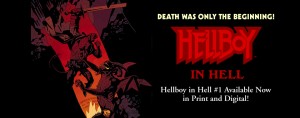
The HELLBOY series, and indeed, the HELLBOY universe complete with B.P.R.D., ABE SAPIEN and the lot, has been building steadily toward the HELL arc with plenty of conjecture over what exactly Hellboy’s role will be in the end of the world. THE WILD HUNT arc revealed Hellboy’s role as the rightful heir of the throne of Britain via intricate mythological storylines, only to culminate in what seemed like the worst fate imaginable for fans: Hellboy’s death by having his heart ripped out. No amount of hinting from Mignola and Dark Horse that this was not the end for the well-meaning devil could really erase the sense that Hellboy’s story was drawing to a close, and it was a bitter sweet revelation. Fans want to know how his story ends, but of course do not want his story to end at all. At New York Comic Con 2012 in a panel devoted to HELLBOY IN HELL, Mignola painted a cheerier picture. It’s been a long road for Mignola, and Hellboy, and tying up all the loose ends, the meaningful details, and the wider apocalyptic thrust of the B.P.R.D. series must be a logistical nightmare, and one which Mignola felt very keenly must be done well, and satisfyingly, or not at all.Some of Mignola’s prophecies at NYCC 2012 have already come to pass in issue #1. For one thing, characters who die in HELLBOY “become more interesting”.
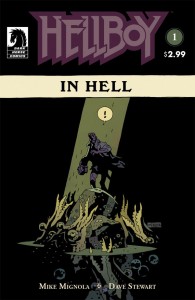
That’s no surprise to readers, who have watched Hellboy battle ghosts, monster, and demon-princes from the Netherworld time and again, but leave it to Mignola to find a way to reverse the typical encounter paradigm. With Hellboy himself dead, he faces the dead or the never living on their own turf, turf which theoretically Hellboy finds native. That very fact, however, provides unique dramatic tension. It’s the equivalent of throwing Batman into Arkham Asylum with the inmates he has personally incarcerated over the years. Many of the dead in Hell were sent there by Hellboy and are burning for a little payback. This is essentially a new situation for Hellboy, and therefore a treat for faithful readers. What’s surprising is that even Hellboy’s going to need a little help to deal with his descent into Hell. Mignola has always been masterful at sculpting folklore traditions to suit the needs of his stories, but keeping interpretation loose enough to allow him to tell his own tale. HELLBOY IN HELL is bound to be shaped by literary and folklore traditions about the underworld, and most cultures have a version of this descent in their collective memories. There is usually a guide, for instance, a Virgil to guide Dante. Here Sir Edward, corpse-like with a creepy mask, volunteers, employing necromantic skills to protect Hellboy from the immediate wrath of enemies. Leave it to Mignola to manage to bring in a haunting puppet-show and thematically relevant lines from Charles Dickens’ A CHRISTMAS CAROL this close to Christmas to strike a little fear into the hearts of readers.
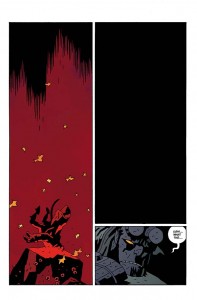
No good HELLBOY issue functions without a knock-down, drag-out fight, and this is no exception, only this time, Hellboy has nearly met his match in Eligos, a “Duke and Knight of the Order of the Fly”, whom Hellboy cast into the pit previously. Perhaps the biggest surprise of the issue is when readers learn that these encounters are taking place in “The Abyss”, only “the outer edge” of Hell. It certainly makes you wonder what grander revelations are to come, especially since the next issue is entitled “Pandaemonium”, which is the capitol of Hell in Milton’s PARADISE LOST, the gathering place of Hell’s elite. Mignola’s return to HELLBOY does not disappoint, from it’s lavish full page spreads of “The Abyss” to the sepulchral eeriness of the puppet show, but if there are any drawbacks, it’s only that the issue is a very quick read due to limited dialogue in a comic that shows astonishing things rather than tells about them. The visual details that remain unexplained, however, invite readers to start putting the pieces of the puzzle together on Hellboy’s final journey, and I don’t think you’ll hear many complaints. HELLBOY in HELL returns to the grandeur of earlier HELLBOY stories with Mignola as artist and writer in an suitably majestic way, reminding readers that all along, Hellboy’s story has been epic.
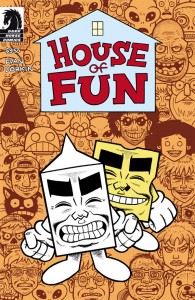
Evan Dorkin’s HOUSE OF FUN couldn’t be more different in format than HELLBOY IN HELL; HELLBOY’s expansive page and panel layouts, conjuring the voids of the netherworld meet a comic so packed with art and storytelling that no reader could accuse HOUSE OF FUN of being less than its worth in cover price. In fact, HOUSE OF FUN is like getting an entire collected edition in one shot, reminding readers what they love about Dorkin: his work is a wild informational overload via both imagery and language. Dorkin’s never been absent from the indie comics scene, but the past year has seen a steady build in press for him, from the award winning BEASTS OF BURDEN with Jill Thompson to the repeatedly back-ordered hardcover edition of MILK AND CHEESE, and HOUSE OF FUN strikes another high-note for fans. This one-shot collects several shorts that originally appeared in DARK HORSE PRESENTS #11-12, but Dorkin’s avatar on the inside cover also warns readers, “It’s been awhile since I made a bunch of comics all by myself like an immature adult, so I hope you like reading them as much as I liked making them! Yeah.”. I’ll go out on a limb and speak for readers by saying, please, Dark Horse, allow Dorkin to be an immature adult as much as possible if this is the result.

The MILK and CHEESE segments of the comic alone are worth the cover price of the book, maybe even just the opening page wherein the due order “X-Ray Spex” and attain superpowers of the utmost degree, declaring “Our eyes now have mad skillz!” and they “can see through everything now! Feng Shui! Scientology! Family Guy!”. Unsurprisingly, violence ensues, but not without plenty of psychological commentary on the power of suggestion. THE MURDER FAMILY “living next door” takes readers deep into the dark heart of suburbia with household chores like “dusting, vacuuming, embalming” and fears that Dad’s “been going out killing with another woman!”. The “fun” compressed into this issue includes “The Haiku of the Ancient Sub-Mariner”, “Broken Robot”, and even “Dr. Who: the 25th Doctor” in unrestrained satire of pop culture storytelling grounded in detailed, and biting observation.
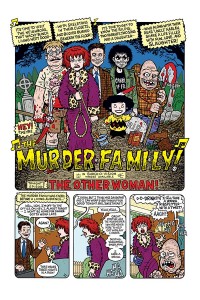
“The Eltingville Comic Book. Science Fiction, Fantasy, Horror, and Role Playing Club” appear (and that must be one of the longest names of a fan group to appear in comics, though certainly accurate of real-life counterparts) to deliver weighty prose commentary on zombie-fever in the media, for instance, Gary’s rejoinder, “Surely, you are high. Everybody knows slow-moving zombies are lame and boring and about as scary as Scooby-Doo. Why do you think the base locomotion of the modern film zombie has steadily been on the rise?”. You could call this meta-commentary on the medium, since the club members themselves appear as zombies on a zombie walk, but “meta” disappears in HOUSE OF FUN within the increasingly intricate layers of sub-text. This one-shot also contains an added bonus for fans: Dorkin’s sketches for a comic that he once planned to contain many of the included stories, DORK #12, as well as a few of his zombie layouts.
While HELLBOY IN HELL #1 encourages re-reading to scour for hints and details that may indicate the direction of future issues or help tie #1 to the vast and varied HELLBOY past, HOUSE OF FUN will have fans re-reading to pick apart the corresponding gags between the mile-a-minute text and the elaborately dense panels. One thing is certain: neither comic will easily end up in a dollar bin. These are keepers, milestones for both Mignola and Dorkin, and are the likely candidates to turn up again and again at signings in the near future. Snag your copies while you can.
Hannah Means-Shannon writes and blogs about comics for TRIP CITY and Sequart.org and is currently working on books about Neil Gaiman and Alan Moore for Sequart. She is @hannahmenzies on Twitter and hannahmenziesblog on WordPress.

By: Alice,
on 9/7/2012
Blog:
OUPblog
(
Login to Add to MyJacketFlap)
JacketFlap tags:
professor,
Dante,
philosopher,
galileo,
Humanities,
italian literature,
*Featured,
Physics & Chemistry,
Science & Medicine,
galileo’s,
Ariosto,
Commedia dell’Arte,
courtier,
Dialogue on the two chief world systems,
Gerusalemme Liberata,
John L. Heilbron,
Orlando Furioso,
Petrarch,
Tasso,
littérateur,
Literature,
Add a tag
By John L. Heilbron
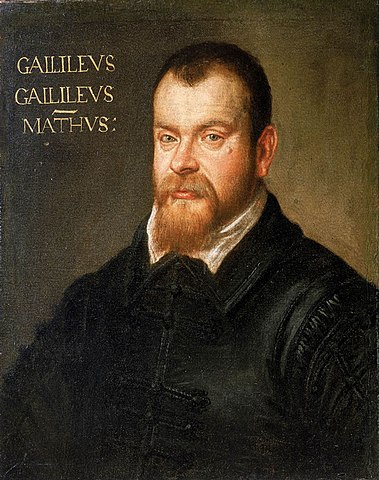
Galileo Galilei by Domenico Tintoretto, 1605-1607.
Galileo is not a fresh subject for a biography. Why then another? The character of the man, his discovery of new worlds, his fight with the Roman Catholic Church, and his scientific legacy have inspired many good books, thousands of articles, plays, pictures, exhibits, statues, a colossal tomb, and an entire museum. In all this, however, there was a chink.
Galileo cultivated an interest in Italian literature. He commented on the poetry of Petrarch and Dante and imitated the burlesques of Berni and Ruzzante. His special favorite was Ariosto’s Orlando Furioso, which he prized for its balance of form, wit, and nonsense. His special dislike was Tasso’s Gerusalemme Liberata (The Liberation of Jerusalem), which violated his notions of heroic behavior and ordinary prosody. Galileo tried his hand at sonnets, sketched plots in the style of the Commedia dell’Arte, and delivered much of his science in dialogues.
The literary side of Galileo is not a discovery; a large specialist literature is devoted to it. But there is a gap in scholarship between the literary Galileo and the rest of him. How were his choices in science and literature complementary and reinforcing? What might be learned from his pronounced literary preferences about the unusual and creative features of his physics? How does Galileo’s praise of Ariosto and criticism of Tasso, on the one hand, parallel his embrace of Archimedes and rejection of Aristotle on the other?
Usually Galileo enters his biography already possessed of most of the convictions and concerns that prompted his discoveries and precipitated his troubles. One reason for endowing him with such precocity is that the documentation for his life before the age of 35 is relatively sparse. In contrast, a quantity of reliable information exists for his later life, after he had transformed a popular toy into an astronomical telescope and himself from a Venetian professor into a Florentine courtier (that happened in 1609/10 when he was 45). By paying attention to his early literary pursuits and associates, however, it is possible to tease out enough about his circumstances as a young man to give him a character different from the cantankerous star-gazer, abstract reasoner, and scientific martyr he became.
A quarrelsome philosopher, half-professor and half-courtier, whose discoveries refashioned the heavens and whose provocative use of them brought him into hopeless conflict with authority, is an attractive subject for portraiture. Add Galileo’s life-long engagement with imaginative writing and the would-be portraitist has his or her hands full. But the resultant picture, even if well-executed, would be a caricature. Galileo initially made his living and gained his reputation as a mathematician. Leave out his mathematics and you may have a compelling character, but not Galileo.
The mathematician and the littérateur have different ways of arguing. To fit together, one sometimes must give way. Galileo’s great polemical work, Dialogue on the two chief world systems, which misleadingly resembles a work of science, frequently privileges rhetoric over mathematics. When the scientific arguments are weakest, the two protagonists in the Dialogue who represent Galileo (his dead buddies Salviati and Sagredo) outdo one another in praising his contrivances and in twitting the third party to the discussions, the bumbling good-natured school philosopher Simplicio, for ignorance of geometry.
The mathematical inventions of the Dialogue that Galileo’s creatures noisily rate as unsurpassed marvels are precisely those that have given commentators the greatest difficulty. These inventions are extremely clever but evidently flawed if taken to be true of the world in which we live. Commentators tend either to interpret the cleverness as shrewd anticipations of later science or to condemn the shortfalls as just plain errors. From my point of view, these marvels should be interpreted as literary devices, conundrums, extravaganzas, inventions too good not to be true in some world if not in ours. They are hints at the form, not the completed ingredients, of a mathematical physics. Galileo’s old Dialogue and today’s Physical Review belong to different genres. Unfortunately, just as the Dialogue was not intended to meet the requirements of accuracy and verisimilitude of modern science journals, so the journals don’t reward the sort of wit and style with which Galileo brought together his literary aspirations, polemical agenda, and scientific insights.
John Heilbron is Professor of History and Vice Chancellor Emeritus of the University of California at Berkeley. One of the most distinguished historians of science, his books include Galileo, The Sun in the Church (a New York Times Notable Book) and The Oxford Companion to the History of Modern Science.
Subscribe to the OUPblog via email or RSS.
Subscribe to only physics and chemistry articles on the OUPblog via email or RSS.
Subscribe to only literature articles on the OUPblog via email or RSS.
View more about this book on the 



By: HannaO,
on 10/29/2010
Blog:
OUPblog
(
Login to Add to MyJacketFlap)
JacketFlap tags:
Poetry,
Literature,
Biography,
Featured,
robert browning,
cantos,
ezra pound,
Dante,
browning,
A. David Moody,
sordello,
ezra,
Add a tag
This Saturday is Ezra Pound’s 125th birthday, so we’ve decided to run an excerpt from Professor A. David Moody’s biography of the poet in his honor.
The Cantos, Ezra Pound’s ambitious, though incomplete, long poem, can at first seem unintelligible and chaotic, a sprawling mess of Latin and Greek, Confucius and Kublai Khan and the Russian Revolution. Yet according to Moody, Pound was inspired, also, by the more traditional structure and form of long poems by earlier poets. In the following selection from Ezra Pound: Poet, A Portrait of the Man and His Work (Volume I), Moody discusses the beginnings of Pound’s epic – and how Pound reconciled the influences of Dante and Robert Browning with the frenzied tenor of the modern world. –Hanna Oldsman, Publicity Intern
[Pound] was going back to his old master not so much to learn as to argue with him and assert his independence. He was taking Browning’s Sordello as a point of departure for his cantos, as ‘the thing to go on from’. He had to start there because he thought it ‘the best long poem in English since Chaucer’, and the only one with a ‘live form’. But that form was not right for what he had to do, and he would be finding his own in breaking free from Browning’s.
He first began to mention being at work on his long poem in the summer of 1915. ‘It is a huge, I was going to say, gamble, but shan’t’, he told Alice Corbin Henderson in early August; and in September he told Milton Bronner that it was ‘a cryselephantine poem of immeasurable length which will occupy me for the next four decades unless it becomes a bore.’ His Scriptor Ignotus, back in 1906, had likewise predicted that the great epic would take just so long to write. He told his father in mid-December that his mind was then ‘in the Vth canto’, but the surviving drafts show that he was still casting about for a form at that date, and it was a full year before he had the first three trial cantos in any sort of shape. [….]
His materials could be endless, immeasurable, but he hardly knew how to put them in order. He had any amount of the past and the present to sort through, and, since he chose to examine it without preconception, it presented itself to him as a vast heap of random records and anecdotes. The best he could do at first was set about abbreviating some of those, and he produced a litter of fragmentary drafts, some of them in typescript. In one of these, headed ‘Fragment / Modern World’, the valet of Ser D’Alviano gossips about what his master was saying about writers and their books in 1520. In another, numbered ‘[page] 102’ and headed ‘Foot Note. A toss-up’, Pound’s visit to the great Provençal scholar Emil Levy in Freiburg is woven into the tale of de Maensac. A sequence of six or seven pages tries out ways to envision paradise, as by seeing points of colour, making stars of them and then making each star ‘a nest of noble voices’. Bits of all those drafts, and others, will turn up in ‘Canto V’, though the visit to ‘old Levy’ will go into

Never mind that
Dante in his
Divine Comedy inscribed these wonderfully horrifying words on the entrance to Hell…this warning should be posted at the threshold of every hero’s journey.
Oh, sure, we’re full of hope for a while. That’s what the middle of a story is all about. Try, try, and try again. All for naught. By any definition of drama, the antagonistic forces must be greater than the hero’s efforts.
In my weekly class, “Don’t Get It Right, Get It Written”, I’ve been hammering away at the importance of seeing the protagonist’s journey as a necessarily tragic one – all the way to the Act II crisis. If you could interview a worthy protagonist at this threshold, she must (by definition) consider this to be the very “gates of story hell”.
Why hell? Because ye who are determined to go ‘all the way’ (see previous post, “Perfect Laughter“) must leave not just your shoes but also your mind outside these gates. Why the mind? Because with its one foot in the past and the other in the future, the mind is not capable of recognizing the opportunity available in a present moment that’s going…all to hell.
Unquestionably, the mind has proven insufficient for the job. The only way to divest oneself of the liability that the mind has become, is to abandon all hope of it leading to a solution. Hence:
“Abandon hope, all ye who enter here.”
At this critical point, we fall under the influence of something more akin to our soul (about which I make no claim to knowing anything).
We read novels and watch films for the vicarious thrill of living the hero’s conundrum as she is unwittingly confronted with Dante’s dictum. In real life – once we’ve lived enough life and read enough books and watched enough good movies – we can practice abandoning hope in our everyday lives.
I know, I know, it’s a paradox: give up hope in order to open to all that is hopeful about our higher natures.
Sounds like grist for another blog post. One that I promise will be less inscrutable than this one.




 Such evidence of ‘poll propulsion’, ‘soft power’ and ‘data optimization’ has not gone without notice on this side of the Atlantic and a whole new wave of election gurus have been recruited to help each of the main three political parties (Nigel Farage, of course, would never recruit such blatant overseas talent, ahem). The Liberal Democrats have recruited Ryan Coetzee who played a leading role significantly increasing the Democratic Alliance’s share of the vote in South Africa. The Conservatives have appointed the Australian Lynton Crosby with his forensic focus on ‘touchstone issues’, while last month the Labour Party revealed they had hired one of President Obama’s key strategists, David Axelrod, to craft a sharp political message and re-brand Ed Miliband.
Such evidence of ‘poll propulsion’, ‘soft power’ and ‘data optimization’ has not gone without notice on this side of the Atlantic and a whole new wave of election gurus have been recruited to help each of the main three political parties (Nigel Farage, of course, would never recruit such blatant overseas talent, ahem). The Liberal Democrats have recruited Ryan Coetzee who played a leading role significantly increasing the Democratic Alliance’s share of the vote in South Africa. The Conservatives have appointed the Australian Lynton Crosby with his forensic focus on ‘touchstone issues’, while last month the Labour Party revealed they had hired one of President Obama’s key strategists, David Axelrod, to craft a sharp political message and re-brand Ed Miliband.
 Until March 24,
Until March 24, 







